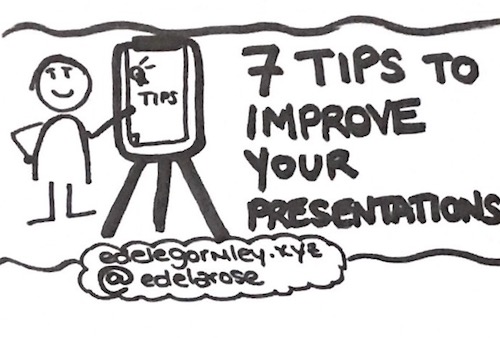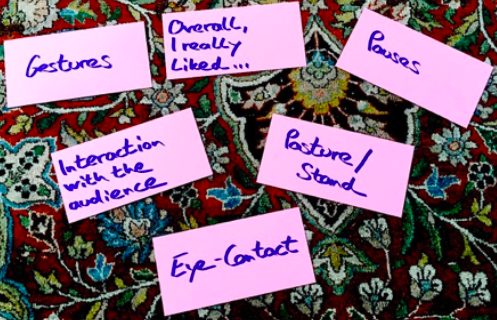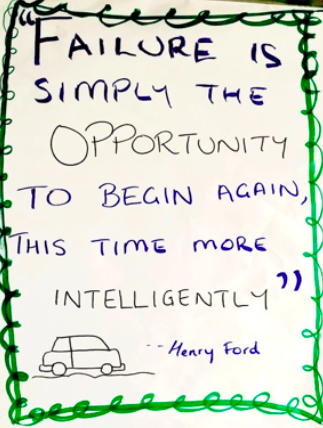
You would think that as an agile coach I’d feel confident at giving presentations. Well, I was confused when my colleague suggested I attend presentation training but decided to give it a shot.
Truth is, I’ve never had any formal presentation training before, but I have refined my technique over the years. In school and university the tendency was to rely on PowerPoint (or similar) which is fine, but over time I grew tired of the “death by PowerPoint” mantra. I found myself spending around 6 hours a day either giving or preparing a presentation, or listening to one, all powered by PowerPoint. A while ago I made the decision to try to use paper-based presentations as much as possible. A personal challenge - I may never be a sketch noter but I want to practice graphic facilitation as much as I can. I feel the best way for me to do this is good old-fashioned pen (ok, markers and sharpies) and paper.
Anyway, I thought I had little to learn when it came to giving good presentations, but I was pleasantly surprised.
Here’s what I learned:
1. Video is powerful
I know I’m not alone when I say I dislike watching videos of myself. However, this was the most powerful tool in helping me to identify my strengths and weaknesses when it comes to giving presentations. Seeing just how much I move around made me realise how distracting this must be for the audience.
2. Pause frequently - Hallelujah!
I was at school when I realised how much I ahh’ed and uhm’ed during presentations and conciously try to limit this as much as possible. However, I did pick up a few good tips for how to manage pauses. As a Celt, I know I have a tendency to speak fast, especially when nervous, so using the “hallelujah” tip is going to be very useful for helping me to break up my sentences.
This is saying the word “hallelujah” in your head each time you reach a comma or full stop - it’s just the right length of time for a pause.
3. Hold those gestures
How did I not know about the importance of holding gestures? Video helped me realise that whilst I do make many relevant gestures during my presentations, I don’t hold them for long enough for the audience to really notice. I admit it felt awkward practicing this, holding a gesture for longer than I felt necessary didn’t come naturally to me. I guess that means I need to practice it more.

4. Repetition, repetition, repetition
So I knew this one already, but the presentation training helped to reinforce it. If you’ve got an important point to make during your presentation, repeat it. Personally, I’m a fan of ‘3’s - repeat the same phrase three times during your presentation (beginning, middle, end) to provide consistency and ensure the audience knows what the key takeaway message is.
5. Prepare for your audience
You might say preparation goes without saying. Here, I’m not talking about the topic per se, but consider how to keep the audience engaged right from the get-go.
Too many presentations start by talking about the reason why you’re gathered, or the agenda. Whilst this might be necessary in certain situations, it’s definitely not needed for all topics. Opening your presentation with a quote or fact will be somewhat unexpected and will grasp the audience’s attention straight away. Think carefully who your audience are, and about the structure of the presentation - remember concentration rates dwindle over time. Maybe throw in something unexpected but familiar - a famous name, movie, or funny gif part-way through your talk might help to re-engage the audience.

6. Have fun!
Sometimes when it comes to work, we forget to have fun. We worry about making an idiot out of ourselves, when really it doesn’t matter in the grand scheme of things. Sure, if you’re a public figure then messing up a presentation could become news-headlines. However, for most of us the worst case scenario is that a few colleagues remember that particular talk - and even then, you can laugh it off. It’s natural to feel nervous but if you can try to have fun, perhaps make a joke and learn to not take it so seriously your presentation will become more fluent and memorable.

7. Video (again - that’s repetition!)
One of the most valuable things I learned at the presentation training was to compare and contrast. Giving two presentations - one at the beginning of the course, one at the end which were both recorded and played back to me helped to realise how quickly I can improve my presentations with just a few tips.
I’m a massive advocate of celebrating successes, but often I forget to celebrate my own as a coach. I’m slowly learning to improve this and that it’s ok to blow my own trumpet from time to time.
Even if you think you have little to learn there are always tips that can help you to inspect and adapt. I really encourage you to find something that you do regularly, and ask for feedback and advice from others - after all, what worked in 2010 may look a little stale in 2017.